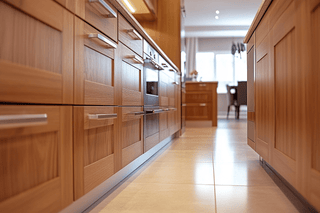This leaves the owner with the two immediate main questions: whether to tile the floor before or after the installation of the kitchen cabinets. Both alternatives have their pluses and minuses, and your decision will rest finally on your budget, design needs, and long-term plans for your kitchen. In this article, we take a look at both ways so that you can make a well-informed decision for yourself and your space.

Laying Tile Flooring Before Cabinets
One trend that has gained significant ground over the past few years is laying tile flooring down the entire kitchen before installation of the cabinets. There are a couple of very large advantages to this system, but there are a few big things to be concerned with as well.
Benefits
Seamless Look
Laying the tile first gives your kitchen a smooth, consistent look. There's no visible gap or break between the cabinets and floor; it instead creates an effect of a single, unified space in visual harmony.
The potential for future renovations is another big plus.
The tile that extends under the cabinets allows for greater flexibility, should the cabinets ever need to be changed or moved, since this can now be done without worry of exposing the subflooring. This is especially nice if you think you may reconfigure the kitchen at some point.
Protection from Water Damage
The advantage of an unbroken tile surface is that it can protect your subfloor from leaks originating from appliances, whether they are refrigerators or dishwashers. Also, by continuing the tile under the cabinets, you can reduce the chance of water seeping into those tight spaces.
Considerations
Higher Material Costs: The materials required in tiling the entire kitchen against those places that the cabinet will be seated will no doubt raise your renovation costs.
Risk of Tile Damage: Placing heavy cabinets and countertops directly on tile can lead to cracks or damage, especially if the tiles are delicate.
If you’re considering installing tile before cabinets, browse options like durable Modern Grey Kitchen Cabinets for a cohesive, modern look.

Installing Tile Flooring After Cabinets
One of the alternative ways is installing the cabinets first before putting in the tile flooring. This is generally preferred by homeowners since it might save them money on materials, and the process is quite generally easier.
Advantages
Saving on Material and Labor Costs
Since you will only be tiling the visible portions of the floor, you save both materials and labor since this method requires fewer tiles.
Minimizes the Risk of Tile Damage
By not installing heavy cabinetry on top of the tile, the potential for cracking or chipping during installation is greatly reduced.
Consistent Cabinet Height
Since the cabinets were installed directly onto the subfloor, a uniform height is achieved, ensuring proper alignment with both countertops and appliances.
Considerations
Future Alterations: If you change your mind about the design of your kitchen sometime in the future, you will have areas of the floor that are not tiled, and renovation will be a real pain.
Appliance Fit: When tile is installed after the cabinets are in place, there can sometimes be height issues, especially with built-in appliances such as dishwashers. To avoid this problem, careful measurements must be taken.
Things to Consider When Choosing
Budget:
If budget is a concern, installing cabinets first can save money on tile and labor costs. However, keep in mind whether the savings is worth the potential limitations to future flexibility.
Durability:
In kitchens with heavy-use tiles, such as porcelain or ceramic, it would be more durable in the long run to install tile before cabinets. Check out our Frost White Cabinets for a timeless and durable pairing with tiled floors.
Aesthetic Preferences:
If a seamless, high-end appearance is of great importance, then tiling before the installation of cabinets is ideal. It will result in a much more professional finish, especially when combined with designs such as Shaker Cabinets.
Simplicity in installation is an added advantage: when using a cabinets-first approach, tiling becomes much simpler since it will just be a matter of covering the exposed areas. That said, this choice might limit design flexibility down the line.
Tips for Your Kitchen Remodel
For a successful kitchen remodel, consider the following:
Plan Ahead: Consider what you want in your kitchen long-term. If you know you'll remodel in the future, tiling first provides greater flexibility.
Consult Professionals: Your contractor or kitchen designer will have some valuable insight as to what works best in your space.
Choose Quality Materials: Good-quality tiles and cabinetry go a long way in creating a kitchen that is going to be both functional and beautiful for many years to come. For more inspiration, check out our Dark Grey Kitchen Cabinets and our Indigo Blue Cabinets in order to find the one that will match your floors perfectly.

Conclusion
The decision to have tile flooring installed before or after the kitchen cabinets actually comes down to your priorities and renovation goals. Tiling first creates a seamless, versatile aesthetic; tiling after the cabinets can be less expensive and reduce some of the risks of installation. Weighing the pros and cons of each will go a long way toward creating a kitchen that suits your style, budget, and needs in the future.
With HomeCabinets, be prepared to get the widest selection of quality cabinets that would perfectly complement any choice of flooring. From classic White Shaker Kitchen Cabinets to bold, striking modern designs, our products promise to elevate both functionality and style in your kitchen. Start renovating today and make your dream kitchen a reality!

























